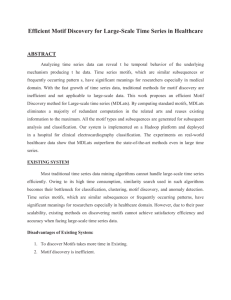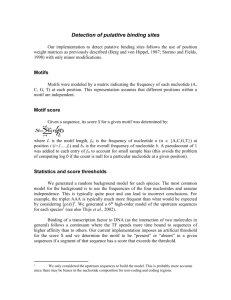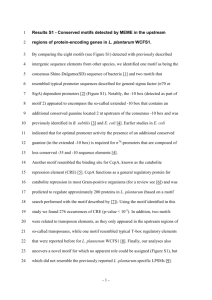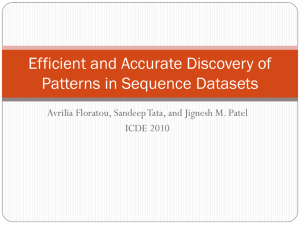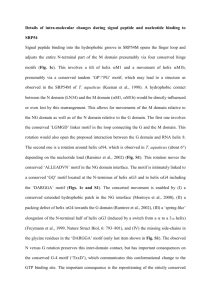file - BioMed Central
advertisement
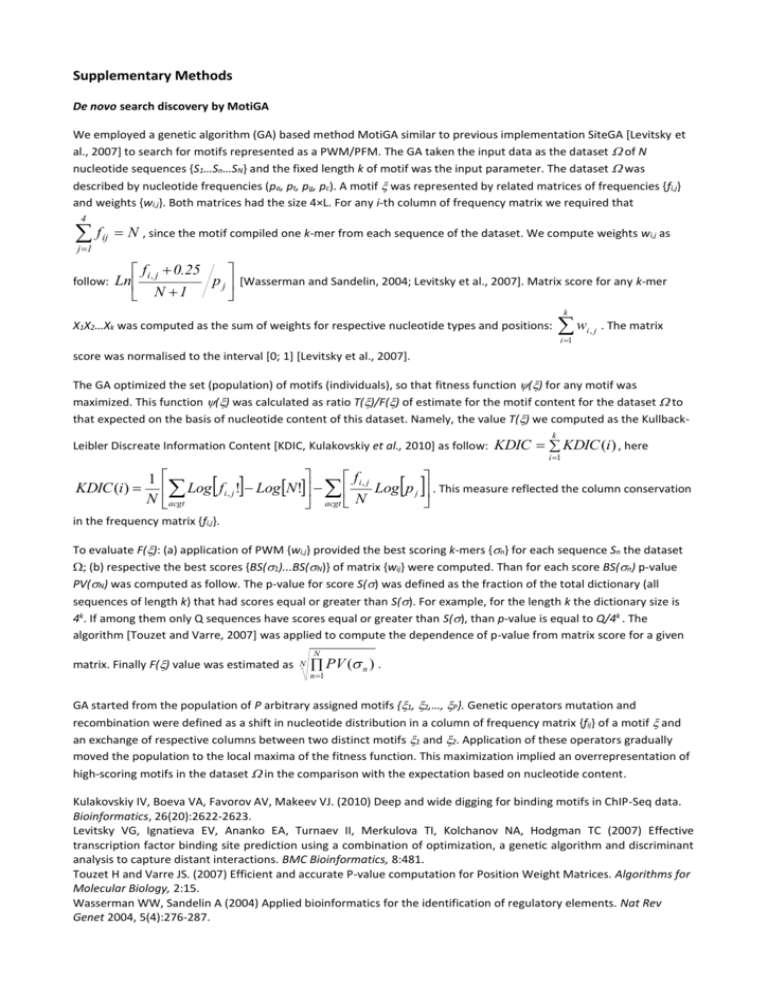
Supplementary Methods
De novo search discovery by MotiGA
We employed a genetic algorithm (GA) based method MotiGA similar to previous implementation SiteGA [Levitsky et
al., 2007] to search for motifs represented as a PWM/PFM. The GA taken the input data as the dataset of N
nucleotide sequences {S1…Sn…SN} and the fixed length k of motif was the input parameter. The dataset was
described by nucleotide frequencies (pa, pt, pg, pc). A motif was represented by related matrices of frequencies {fi,j}
and weights {wi,j}. Both matrices had the size 4×L. For any i-th column of frequency matrix we required that
4
f ij N , since the motif compiled one k-mer from each sequence of the dataset. We compute weights w
i,j
as
j 1
follow:
f i , j 0.25
Ln
p j [Wasserman and Sandelin, 2004; Levitsky et al., 2007]. Matrix score for any k-mer
N 1
k
X1X2…Xk was computed as the sum of weights for respective nucleotide types and positions:
w
i 1
i, j
. The matrix
score was normalised to the interval [0; 1] [Levitsky et al., 2007].
The GA optimized the set (population) of motifs (individuals), so that fitness function () for any motif was
maximized. This function () was calculated as ratio T()/F() of estimate for the motif content for the dataset to
that expected on the basis of nucleotide content of this dataset. Namely, the value T() we computed as the Kullbackk
Leibler Discreate Information Content [KDIC, Kulakovskiy et al., 2010] as follow:
KDIC (i)
KDIC KDIC (i ) , here
i 1
fi, j
1
Log p j . This measure reflected the column conservation
Log f i , j ! Log N!
N acgt
acgt N
in the frequency matrix {fi,j}.
To evaluate F(): (a) application of PWM {wi,j} provided the best scoring k-mers {n} for each sequence Sn the dataset
; (b) respective the best scores {BS(1)...BS(N)} of matrix {wij} were computed. Than for each score BS(n) p-value
PV(N) was computed as follow. The p-value for score S() was defined as the fraction of the total dictionary (all
sequences of length k) that had scores equal or greater than S(). For example, for the length k the dictionary size is
4k. If among them only Q sequences have scores equal or greater than S(), than p-value is equal to Q/4k . The
algorithm [Touzet and Varre, 2007] was applied to compute the dependence of p-value from matrix score for a given
matrix. Finally F() value was estimated as
N
N
PV ( n ) .
n 1
GA started from the population of P arbitrary assigned motifs {1, 2,…, P}. Genetic operators mutation and
recombination were defined as a shift in nucleotide distribution in a column of frequency matrix {fij} of a motif and
an exchange of respective columns between two distinct motifs 1 and 2. Application of these operators gradually
moved the population to the local maxima of the fitness function. This maximization implied an overrepresentation of
high-scoring motifs in the dataset in the comparison with the expectation based on nucleotide content.
Kulakovskiy IV, Boeva VA, Favorov AV, Makeev VJ. (2010) Deep and wide digging for binding motifs in ChIP-Seq data.
Bioinformatics, 26(20):2622-2623.
Levitsky VG, Ignatieva EV, Ananko EA, Turnaev II, Merkulova TI, Kolchanov NA, Hodgman TC (2007) Effective
transcription factor binding site prediction using a combination of optimization, a genetic algorithm and discriminant
analysis to capture distant interactions. BMC Bioinformatics, 8:481.
Touzet H and Varre JS. (2007) Efficient and accurate P-value computation for Position Weight Matrices. Algorithms for
Molecular Biology, 2:15.
Wasserman WW, Sandelin A (2004) Applied bioinformatics for the identification of regulatory elements. Nat Rev
Genet 2004, 5(4):276-287.
